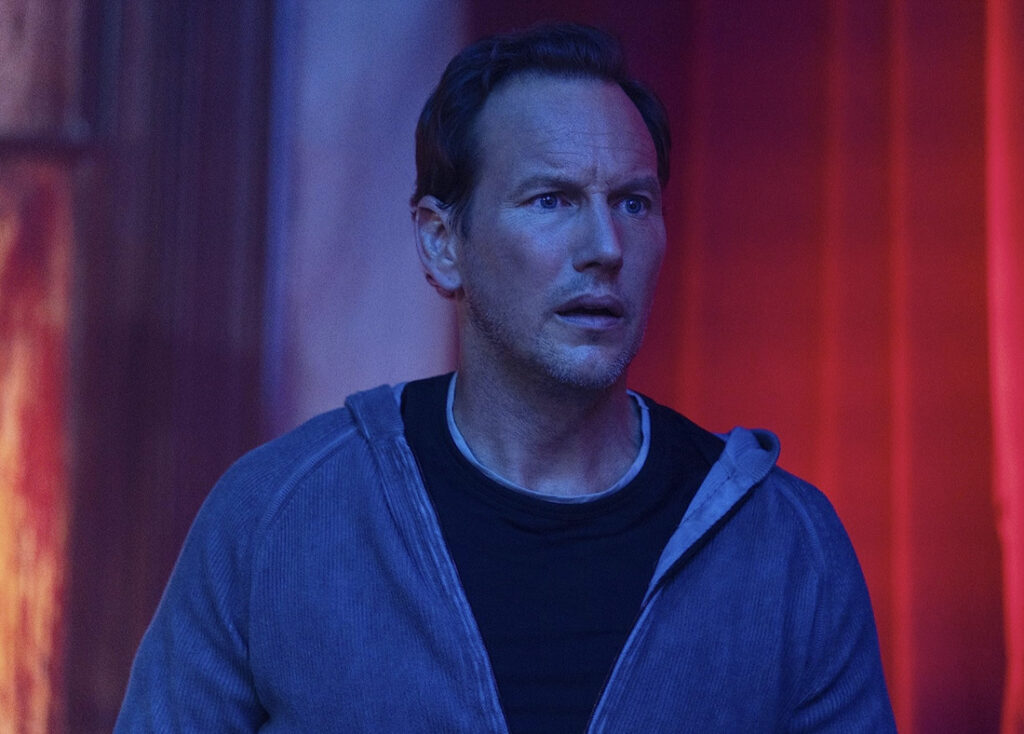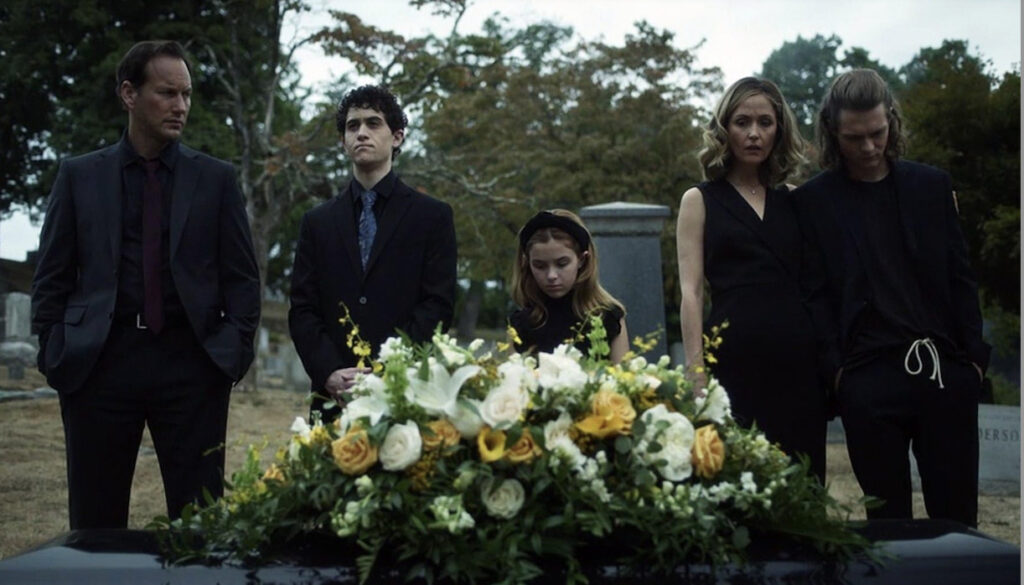
Embarking on an emotional exploration into the haunted memories of the past to help improve the future is a powerful journey for both the protagonists and filmmakers of gripping, tantalizing horror movies. That’s certainly the case for the Lambert family, which was featured in the first two installments of the horror series, Insidious. as well as its returning cast and creative team.
The characters, actors and filmmakers have returned to make a epic conclusion to one of the 2010’s most successful supernatural horror franchises with its fifth entry, Insidious: The Red Door. The new drama serves as an alluring, emotionally-charged direct sequel to the events featured in the series’ first two installments, Insidious and Insidious: Chapter 2. The new follow-up finally offers a satisfying insight into how the events of the original two movie have left a lasting effect on both the Lambert family and the filmmakers, a decade after the events and release of the first sequel.
Insidious: The Red Door, which was written by franchise newcomer Scott Teems (Halloween Kills, last year’s Firestarter remake), is based on characters created by series veteran Leigh Whannell. Teems created the new film’s story with Whannell, the latter of whom also penned the first four entries in the franchise. Patrick Wilson, who also starred in the original two entries in the series, made his feature film directorial debut on Insidious: The Red Door.
The drama was produced by returning franchise producer, Jason Blum. He was joined by Oren Peli (Paranormal Activity); James Wan, who helmed the series’ first two entries and produced its two prequels; and Whannell. Insidious: The Red Door begins with Josh Lambert (Wilson) attending the funeral for his mother, Lorraine (played by Barbara Hershey in the franchise’s first two and fourth movies). He’s joined at her burial with his ex-wife Renai (Rose Bryne), who he became divorced from in the nine years since the events of Insidious: Chapter 2.
The former couple’s oldest son, Dalton (Ty Simpkins, reprising the role from when he was a child in the first two films), reads from Scripture. His younger siblings, Foster (Andrew Astor, who also reprised the role from when he was a child in the original two movies) and Kali (series newcomer Juliana Davies), are mourning the loss of their grandmother with their parents, despite their estrangement from their father.
Immediately after the funeral, Josh has a chance encounter with Carl (Steve Coulter), the man who erased Josh and Dalton’s memories of entering and being in The Further during the first two films, at the cemetery. The unexpected meeting with Carl, who Josh doesn’t remember, combined with his grief over losing his mother, leaves him questioning why his mental state has become so hazy in recent years.
Still in his grief-stricken state, Josh then tries to rekindle his broken bond with his oldest son, who’s preparing to start his first year as an art student at college. While helping Dalton move into the dorm at his new school, their attempt to reconcile is further strained due to an unresolved argument. Instead of trying to repair his strained relationship with his father, Dalton begins to rely on his new connection with Chris (Sinclair Daniel), who was mistakenly assigned to be his roommate, due to a clerical error, to contend with his feelings. The two become friends as she accepts his quirks and avoidant demeanor.

@Insidious : The Red Door
Dalton’s behavior becomes increasingly troubling after he participates in a harrowing art class exercise, during which he sketched the titular red door. The assignment leads both Dalton and Josh back into The Further, during which they reconnect to finally defeat their demons, including The Bride in Black and The Lipstick Face Demon, once and for all. The first two installments in the Insidious franchise thrived on their ability to interweave the presence of a menacing demon in both The Further and the living world that was intent on harming all aspects of the Lambert family’s lives. Josh and Dalton’s shared ability to astral project into The Further with the help of parapsychologist Elise Rainier helps them figure out the demons’ motives and how to stop them was both physically and emotionally frightening.
Unfortunately, Insidious: The Red Door fails to live up to the tension and scares of its two predecessors. Without the introduction a new demon to lure Josh and his oldest son back into The Further, the duo end up contending with scarce, lackluster moments of supernatural phenomena. These moments don’t offer much tension or a dire need to return to The Further to once again save their lives. The father and son duo’s journey also feels disjointed at times, as they spend most of their time in both The Further and reality on their own separate journeys. Instead of being trapped together mainly in one location of their seemingly haunted house, like the first two entries in the series, Josh is now living in his late mother’s home by himself, while Dalton is at his college campus.
As a result, the story drifts slowly between the father and son’s personal storylines for a majority of the drama, before their narratives finally do converge as they reconnect in The Further. But even their present reunion is cut short by the interweaving of scenes from the first two movies, which do successfully offer some new perspective on the Lambert family’s harrowing past interactions. Despite several at-times unfulfilling plot points in the script from Teems, Wilson thrives in his directorial debut in the final installment of the franchise that helped make him a horror icon. His award-nominated performances in the first two Insidious films allowed him to craft an overall emotionally and visually satisfying conclusion to the series with The Red Door.
Wilson collaborated with the drama’s cinematographer, Autumn Eakin, who previously worked on last year’s supernatural horror thriller, The Invitation, to stunningly bring the new follow-up’s menacing world to life. From intense close-up framing of Josh and his son’s reactions to the reemergence of their old demonic foes to sweeping wide shots of the stellar locations, Eakin presents The Red Door in classic Insidious fashion that mirrors its predecessors. The Lambert family’s reality and The Further are also presented in dazzling clashing colors, much like the franchise’s first four entries. While contending with their grief of losing Lorraine and struggles of their estrangement, Josh and his children’s waking moments in their homes and school are presented in realistic, and at-times muted, colors. But once Josh and Dalton enter The Further, Eakin emphasizes the dark, grim blues and blacks that capture the daunting nature of the father and son slipping back into the supernatural realm.
While the series’ concluding installment doesn’t completely live up to the tension and scares of its predecessors, Wilson still thrives in his directorial debut. Insidious: The Red Door is an overall emotionally gripping and visually stunning dive into the haunted memories of the past. Overall, it wraps the Lambert family’s tumultuous journey over the past decade, both in The Further and the real world, in an organic, satisfying way.

@Insidious : The Red Door
Grade: B
Insidious: The Red Door is now playing in theaters, courtesy of Sony Pictures Releasing.

